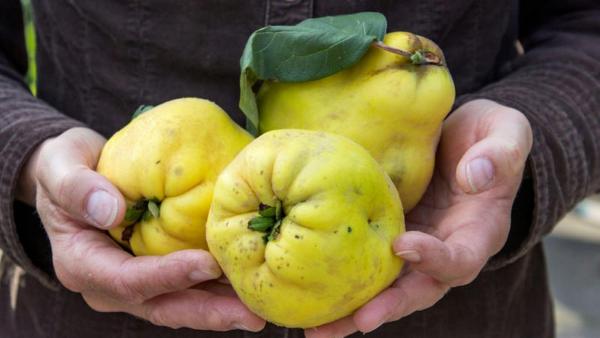Dripping Gardening November 14

Around this time of year, I feel like it is both my duty and my pleasure to write a missive on quince. Do you know about the quince? It’s a fall fringe fruit that is delightfully fragrant and deserves a comeback. Quince is a tough fruit, not well known, and often hard to come by. But it has the most amazing sweet and secret surprise reward. It grows in a manner quite like apples and pears — but its similarities end there.
Not too many years ago, the quince was the talk of the town, eaten by kings, queens and commoners. Often eaten with wild game, it was just as popular, if not more so, than its better cousins’ apples and pears. With a renewed appreciation for local produce and farmers markets all over the country these days, it seems the time is ripe for a quince revival.
Quince is an ancient fruit, found in Roman cooking and grown across Turkey and southeast Asia. It grows on small trees like those apples and pears I keep mentioning, but it lacks their immediate edibility and appeal.
The fruit is knobby and ugly, with an irregular shape and often a gray fuzz — especially when the fruit has been picked underripe. The ripest, nicest quince will have a golden tone and smooth skin like pictured directly above. But even ripe quince doesn’t taste very good raw. It also has an extremely tough and spongy flesh, which is difficult to cut up; I fear for my fingers every time I attack the woody, oddly spongy yet unyielding interior of a quince.
So, if the quince is so much trouble, why even bother with these fruits? You can’t eat them raw, and they’re not even tasty? That’s where the surprise comes in. Quince may be the most difficult, yet rewarding, fruit I have ever encountered. It’s completely inedible when raw, which puts it even above the persimmon in unapproachable astringency. (At least the persimmon will ripen, eventually, into edible sweetness.)
Quince is considered native to the Caucasus region and Western Asia, but has made its way all over the world, winning particularly ardent fans in Spain, France and Portugal with its jellies and jams. In fact, the word "marmalade" originally referred to quince jam, thanks to the Portuguese word for quince, "marmelo."
Once quince came over to the New World, it quickly caught on with colonial women, who made use of its high pectin content by making plenty of preserves. It was not uncommon for a quince tree or two to be planted in the orchards and vegetable gardens of the New England colonies, but it grows well in zones 5 through 9 so, we can grow it in central Texas.
Today, quince paste is still extremely popular in the Iberian Peninsula and in Spanish-speaking countries, with dulce de membrillo often served in sandwiches or with Manchego cheese as an after-dinner dessert. The firm, sticky, sweet paste is also a wonderful addition to your cheese or charcuterie boards. Quince also offers a wealth of health benefits: it's high in vitamin C, zinc, iron, copper, iron, potassium and fiber.
Unfortunately, it's tough these days to find quince in a North American grocery store, but it's worth asking around! I sometimes have good luck finding it in the produce section at Whole Foods. Also ask around at the farmers market; often an orchard will have just one or two quince trees growing in a lonesome corner that someone’s grandfather planted 50 years ago.
Your best bet might be finding a neighbor who has a shrub in their backyard; the deciduous quince tree is often grown for its ornamental qualities and pretty pale pink blossoms. Though quince was originally grown in the English colonies, American farmers took them westward to cultivate in Texas and California, but there's still not a nationwide commercial quince industry (yet).
Perhaps the most important thing to know about quince is that you can't eat it raw; unless, of course, you like your fruit hard, woody and very astringent. You'll know a quince is ripe once it's fully yellow and its intoxicating fragrance is already in the air. My great grandmother told us to “leave her alone until she has her perfume on!” She was right as the first clue that quince hides something special is its aroma. If you leave a quince on a sunny windowsill it will slowly release a delicate fragrance of vanilla, citrus, and apple into your kitchen. It’s a heady, perfumed scent that is completely at odds with its appearance.
And then, if you peel a quince and hack it up, then cook it, those scents blossom into an indescribably wonderful perfume, and the fruit itself magically turns from yellowed white to a deep rosy pink. When you stew quince in sugar and a little water or wine, it becomes not just edible but delicious — sweet, delicate, fragrant.
Perhaps the best part about cooking with quince is the magical transformation of its color and flavor. Because there's so much pectin in the fruit, you'll need to roll up your sleeves and give it some tough love and affection. A sharp paring knife and careful carving skills are essential; the quince's tough skin doesn't always peel away easily. Despite that chore, you'll always want to remove the peel and core the fruit before cooking, and then you can roast, stew, puree, jelly, poach, bake or grill them to your heart's content. I have tried them prepared many different ways and the quince never disappoints, but if you want to keep it simple, poaching or stewing it in a sugary liquid is best. It's also a two-for-one, as you'll get tender fruit for baking and a syrup that you'll want to drizzle on just about everything including my personal favorite, oatmeal.
I understand that we are all trying to cut back on sweets in our diets, but don't be shy with the sugar, as quince is pretty bitter. Then put your own twist on flavors while you stew it — fresh ginger, vanilla beans, rosemary (I love this addition), lemon peels or cinnamon sticks are all welcome additions.
Another delightful surprise about quince? The longer you cook it, the prettier it becomes. That gnarled, knobby, homely little fruit will transform into a brilliant salmon-pink with the help of some heat and steam.
Once the quince is cooked, it’s soft and tender, usually with a really lovely syrup from the cooking process. You eat the fruit straight like this, or pour it over yogurt, ice cream, or bake it into a tart. You can make a sweet, spicy paste out of it (known as membrillo in Spain) that is magnificent with cheese. Personally, I love making sorbet and other desserts with it too.
Quince are not nearly as popular as apples and pears, of course, and the work of cooking them is part of this.
Perhaps the magical transformation, in the cooking process, is what makes quince so appealing. It’s like a magic trick, a miracle of water into wine: take a rare, inedible, ugly fruit, and produce something delicious. Add in the fact that quince are often hard to find (that element of the hunt appeals to me, I suppose), and you can see how I’ve become more than a little obsessed.



